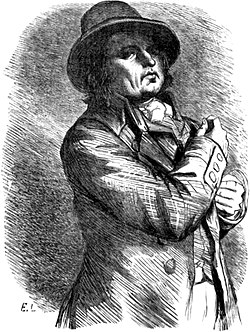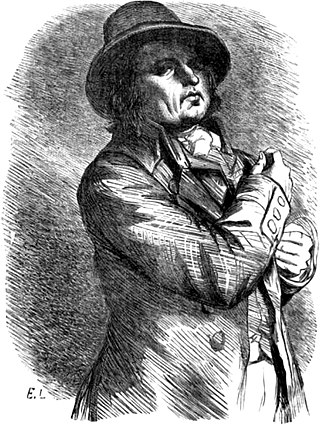Charles-Henri Sanson
French executioner (1739–1806) From Wikipedia, the free encyclopedia
Charles-Henri Sanson, full title Chevalier Charles-Henri Sanson de Longval (French pronunciation: [ʃaʁl ɑ̃ʁi sɑ̃sɔ̃]; 15 February 1739 – 4 July 1806), was the royal executioner of France during the reign of King Louis XVI, as well as high executioner of the First French Republic. He administered capital punishment in Paris for over 40 years. By his own hand he executed nearly 3,000 people, including Robert-François Damiens who attempted to assassinate King Louis XV. Sanson was the executioner of Louis XVI.
Charles-Henri Sanson | |
|---|---|
 Imaginary portrait of Charles-Henri Sanson by Eugène Lampsonius in "An Episode during the Terror" by Balzac. | |
| Born | 15 February 1739 |
| Died | 4 July 1806 (aged 67) Paris, France |
| Nationality | French |
| Occupation(s) | Royal executioner of France, high executioner of the First French Republic |
| Known for | Performing the execution of Louis XVI |
Life and family
Sanson was born in Paris to Charles Jean-Baptiste Sanson and his first wife Madeleine Tronson. Sanson was the fourth in a six-generation family dynasty of executioners. His great-grandfather, Charles Sanson (1658–1695) of Abbeville, was a soldier in the French royal army and was appointed as executioner of Paris in 1688.[1] Upon his death he passed the office to his son named Charles (1681–1726). When this second Charles died, an official regency held the position until his young son, Charles Jean-Baptiste Sanson (1719–1778), reached maturity. The third Sanson served all his life as high executioner and in his time fathered 16 children, 10 of whom survived to adulthood.
Sanson was first raised in the convent school at Rouen until in 1753 a father of another student recognised his father as the executioner, and he had to leave the school in order to not ruin the school's reputation. He was then privately educated. The eldest of his siblings, he was apprenticed to his father for 20 years and was sworn into the office of executioner on 26 December 1778.[2]
Career
Summarize
Perspective




His father's paralysis and the assertiveness of his paternal grandmother, Anne-Marthe Sanson, led Charles-Henri to leave his study of medicine and to assume the job of executioner in order to guarantee the livelihood of his family. As executioner (bourreau), he came to be known as "Monsieur de Paris"—"Gentleman of Paris". On January 10, 1765, he married his second wife, Marie-Anne Jugier. They had two sons: Gabriel (1767–1792) and Henri (1769–1830).
In 1757 Sanson assisted his uncle Nicolas-Charles-Gabriel Sanson (1721–1795, executioner of Reims) with the extremely gruesome execution of the king's attempted assassin Robert-François Damiens. His uncle quit his position as executioner after this event. In 1778 Charles-Henri officially received the blood-red coat, the sign of the master executioner, from his father Charles-Jean-Baptiste. He held this position for 17 years, being succeeded by his son Henri in 1795 after he showed serious signs of illness. Most of the executions were performed by Sanson and up to six assistants.[3]
Sanson was the first executioner to use the guillotine, and he led the initial inspection and testing of its prototype on 17 April 1792, at Bicêtre Hospital in Paris. Swift and efficient decapitations of straw bales were followed by live sheep and finally human corpses, and by the end, Sanson led the inspectors in pronouncing the new device a resounding success.[4] Within the week, the Legislative Assembly had approved its use and on 25 April, Sanson inaugurated the era of the guillotine by executing Nicolas Jacques Pelletier at the Place de Grève for robbery and assault.[5][6] The use of the guillotine transformed Sanson's status under the revolutionary ideology from outcast to citizen, equal in rights and civil duties.[3]
Sanson performed 2,918 executions, including the execution of Louis XVI. Even though he was not a supporter of the monarchy, Sanson was initially reluctant to execute the king but in the end performed the execution. As David Jordan notes, "No Monsieur de Paris had ever had the honor of executing a king, and Sanson wanted precise instructions."[7] Sanson experienced the political and psychological pressures of revolutionary Paris. He had the duty to execute Louis XVI under the power of the sitting provisional government. Being the heir to a line of executioners, to refuse this duty would have brought shame to the family name and danger to himself and to his family members. He experienced the stress of having to execute not only the king but also successive waves of ousted officials as those in power shifted rapidly in a time of revolutionary change. The execution of Louis XVI was of particular importance. Fearing rescue efforts, the streets of Paris were lined with troops as Louis's carriage took its somber two hours to travel to the scaffold arriving at 10 a.m. on 21 January 1793. After Sanson efficiently cut his hair, Louis attempted to address the crowd but was silenced with a drum roll, and Louis was beheaded, with Sanson's assistant pulling his head from the basket immediately after to show to the crowd.[8] But the execution may not have gone as smoothly as possible: "One of two accounts of Louis' death suggest the blade did not sever his whole neck in one go, and had to be borne down on by the executioner to get a clean cut."[9] Quite possibly, then, the execution went from being quick and fast to being more difficult and painful. As David Andress notes, however, "With his spine severed already, it is nevertheless unlikely that Louis could have uttered the 'terrible cry' that one account claims."[9]
On 17 July 1793 Sanson executed assassin Charlotte Corday. After Corday's decapitation, a man named Legros lifted her head from the basket and slapped it on the cheek. Sanson indignantly rejected published reports that Legros was one of his assistants. Sanson stated in his diary that Legros was in fact a carpenter who had been hired to make repairs to the guillotine.[10] Witnesses report an expression of "unequivocal indignation" on her face when her cheek was slapped. The oft-repeated anecdote has served to suggest that victims of the guillotine may in fact retain consciousness for a short while, including by Albert Camus in his Reflections on the Guillotine. ("Charlotte Corday's severed head blushed, it is said, under the executioner's slap."[11]) This offense against a woman executed moments before was considered unacceptable, and Legros was imprisoned for three months because of his outburst.[12]
On 16 October 1793 Marie Antoinette was executed by Sanson's son Henri, an officer in the Garde Nationale. Sanson and his men executed successive waves of well-known revolutionaries, including Hébert, Danton, Desmoulins, Saint-Just, and Robespierre. Less known is Cécile Renault, who was executed together with three family members and 50 others on 17 June 1794; Sanson left the scaffold sick.[13][14][15][16][17]
Guillotine proponent
After the French Revolution, Sanson was instrumental in the adoption of the guillotine as the standard form of execution. After Joseph-Ignace Guillotin publicly proposed Antoine Louis's new execution machine, Sanson delivered a memorandum of unique weight and insight to the French Assembly.[18] Sanson, who owned and maintained all his own equipment, argued persuasively that multiple executions were too demanding for the old methods.
The relatively lightweight tools of his trade broke down under heavy usage, and the repair and replacement costs were prohibitive, unreasonably burdening the executioner. Even worse, the physical exertion required to use them was too taxing and likely to result in accidents, and the victims themselves were likely to resort to acts of desperation during the lengthy, unpredictable procedures.[19]
Death and legacy
Summarize
Perspective
After years of struggling with ill health, Sanson died of disease on 4 July 1806.[20] Sanson's eldest son Gabriel had been his assistant and heir apparent from 1790, but he died after slipping off a scaffold as he displayed a severed head to the crowd.[21] With his death, the hereditary obligation fell to the youngest son. In April 1793, he handed over his office, de facto, to Henri, who held it until his death in 1840, a total of 47 years. Henri guillotined the chief prosecutor Fouquier-Tinville in 1795, among many others.
The Memories of Sanson are the apocryphal memoirs attributed to Sanson. Published in 1830, they were written partially by Honoré de Balzac. In 1847, the last representative of the family Henry-Clément Sanson, decided, after money problems due to gambling, to return to the text and to a supplement, under the title Memoirs of the Sansons; or, Seven generations of Executioners, published in 1862.[22] His grandson Henri Clément (Henry-Clément) was the sixth and last executioner in the family. He worked as an assistant from the 1830s and held the official position from 1840 to 1847, at which point the 159-year Sanson legacy of executioners came to an end.
In the late 1840s the Tussaud brothers Joseph and Francis, gathering relics for Madame Tussauds wax museum, visited the aged Henry-Clément Sanson and secured parts of one of the original guillotines used during the Reign of Terror. The executioner had "pawned his guillotine, and got into woeful trouble for alleged trafficking in municipal property".[23]
References
Further reading
External links
Wikiwand - on
Seamless Wikipedia browsing. On steroids.
